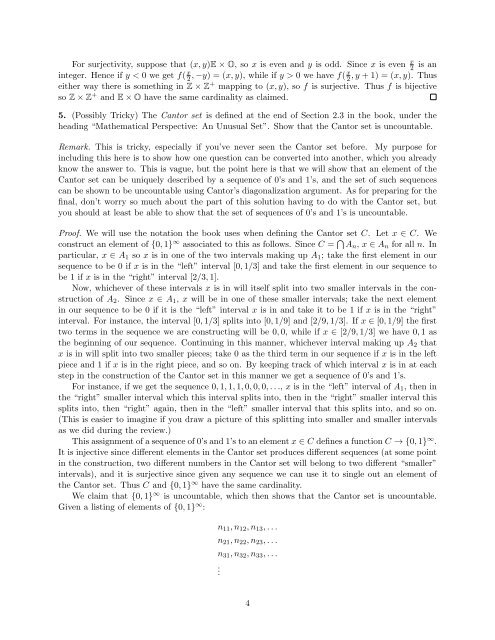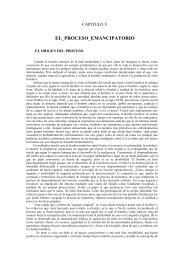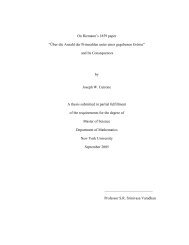Math 300: Final Exam Practice Solutions
Math 300: Final Exam Practice Solutions
Math 300: Final Exam Practice Solutions
Create successful ePaper yourself
Turn your PDF publications into a flip-book with our unique Google optimized e-Paper software.
For surjectivity, suppose that (x, y)E × O, so x is even and y is odd. Since x is even x 2<br />
is an<br />
integer. Hence if y < 0 we get f( x 2 , −y) = (x, y), while if y > 0 we have f(x 2<br />
, y + 1) = (x, y). Thus<br />
either way there is something in Z × Z + mapping to (x, y), so f is surjective. Thus f is bijective<br />
so Z × Z + and E × O have the same cardinality as claimed.<br />
5. (Possibly Tricky) The Cantor set is defined at the end of Section 2.3 in the book, under the<br />
heading “<strong>Math</strong>ematical Perspective: An Unusual Set”. Show that the Cantor set is uncountable.<br />
Remark. This is tricky, especially if you’ve never seen the Cantor set before. My purpose for<br />
including this here is to show how one question can be converted into another, which you already<br />
know the answer to. This is vague, but the point here is that we will show that an element of the<br />
Cantor set can be uniquely described by a sequence of 0’s and 1’s, and the set of such sequences<br />
can be shown to be uncountable using Cantor’s diagonalization argument. As for preparing for the<br />
final, don’t worry so much about the part of this solution having to do with the Cantor set, but<br />
you should at least be able to show that the set of sequences of 0’s and 1’s is uncountable.<br />
Proof. We will use the notation the book uses when defining the Cantor set C. Let x ∈ C. We<br />
construct an element of {0, 1} ∞ associated to this as follows. Since C = ⋂ A n , x ∈ A n for all n. In<br />
particular, x ∈ A 1 so x is in one of the two intervals making up A 1 ; take the first element in our<br />
sequence to be 0 if x is in the “left” interval [0, 1/3] and take the first element in our sequence to<br />
be 1 if x is in the “right” interval [2/3, 1].<br />
Now, whichever of these intervals x is in will itself split into two smaller intervals in the construction<br />
of A 2 . Since x ∈ A 1 , x will be in one of these smaller intervals; take the next element<br />
in our sequence to be 0 if it is the “left” interval x is in and take it to be 1 if x is in the “right”<br />
interval. For instance, the interval [0, 1/3] splits into [0, 1/9] and [2/9, 1/3]. If x ∈ [0, 1/9] the first<br />
two terms in the sequence we are constructing will be 0, 0, while if x ∈ [2/9, 1/3] we have 0, 1 as<br />
the beginning of our sequence. Continuing in this manner, whichever interval making up A 2 that<br />
x is in will split into two smaller pieces; take 0 as the third term in our sequence if x is in the left<br />
piece and 1 if x is in the right piece, and so on. By keeping track of which interval x is in at each<br />
step in the construction of the Cantor set in this manner we get a sequence of 0’s and 1’s.<br />
For instance, if we get the sequence 0, 1, 1, 1, 0, 0, 0, . . ., x is in the “left” interval of A 1 , then in<br />
the “right” smaller interval which this interval splits into, then in the “right” smaller interval this<br />
splits into, then “right” again, then in the “left” smaller interval that this splits into, and so on.<br />
(This is easier to imagine if you draw a picture of this splitting into smaller and smaller intervals<br />
as we did during the review.)<br />
This assignment of a sequence of 0’s and 1’s to an element x ∈ C defines a function C → {0, 1} ∞ .<br />
It is injective since different elements in the Cantor set produces different sequences (at some point<br />
in the construction, two different numbers in the Cantor set will belong to two different “smaller”<br />
intervals), and it is surjective since given any sequence we can use it to single out an element of<br />
the Cantor set. Thus C and {0, 1} ∞ have the same cardinality.<br />
We claim that {0, 1} ∞ is uncountable, which then shows that the Cantor set is uncountable.<br />
Given a listing of elements of {0, 1} ∞ :<br />
n 11 , n 12 , n 13 , . . .<br />
n 21 , n 22 , n 23 , . . .<br />
n 31 , n 32 , n 33 , . . .<br />
.<br />
4





